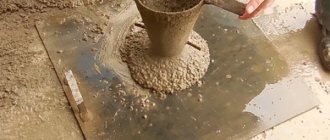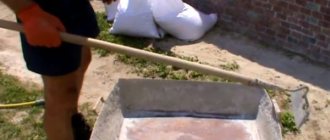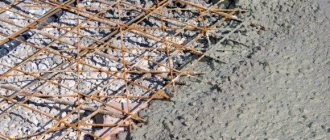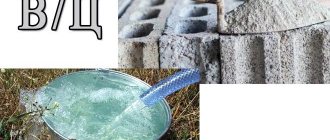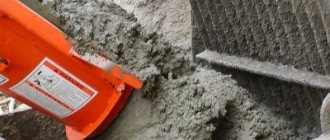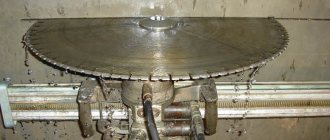- 1 Properties and application
- 2 Composition and proportions
- 3 Manufacturing
- 4 Conclusion
Concrete is an indispensable building material. No construction can be completed without it. The cost of a concrete solution depends on the components included in it and their quantity. There is a large selection of concrete mixtures with different properties. Each mixture has a specific brand. Concrete grade M150 is widely used when pouring reinforced concrete products. It is used in cases where there is no load. Due to its low price and good properties, it has gained popularity among other brands of concrete solutions.
Composition of concrete for the foundation.
The concrete mixture includes: sand, gravel (crushed stone), cement and water.
It is necessary to carefully observe the proportions of concrete for the foundation so that problems do not arise in the future.
To prepare the solution, only clean sand should be used, without any impurities (silt or clay); it should have particles from 1.2 mm to 3.5 mm, but not less. To check if the sand is suitable, you need to pour it into a bottle and fill it with water, and then shake it. If it is clean, the water will remain clear or become slightly cloudy. Sand, which contains a lot of clay, will color the water cloudy, and after it settles, clay sediment will settle on top. Filler of this quality cannot be used.
Mortar for the foundation is in the proportions of cement.
Table of proportions of cement (M400, M500), sand, crushed stone for the desired grade of concrete.
The next ingredient is gravel, you can also use crushed stone instead. It must be clean, or at least contain a minimum amount of clay. Its particle size can vary from 10 mm to 80 mm. Cement comes in various grades such as 200, 300, 400, etc. Each grade indicates the tensile strength of a concrete cube, the edge of which is 200 mm, for compression, expressed in kg/cm 2. after maturation, which occurs within 28 days.
Its grade should be one and a half to two times greater than the grade of concrete. You can also use a lot of additives that can reduce the curing time of the concrete solution, anti-frost and strength additives, and accelerators.
Conclusion
Concrete M150 is a lightweight, not heavy concrete solution. The correct proportion and type of coarse aggregate influence the future mixture. They determine what characteristics the solution will have: strength and density. Additives affect the level of water resistance and frost resistance.
This type of concrete is used for preparatory construction work. Due to its technical properties, it is not able to withstand heavy loads, so it is used for plastering, pouring floors, paths, etc. The concrete solution hardens quickly, which allows construction work to continue after a short period of time.
Concrete proportions.
To prepare the solution, you need to measure the amount of sand, gravel (crushed stone) and water in parts of cement. For 10 kg of cement, 30 kg of sand and 50 kg of gravel (crushed stone) should be added, i.e. the ratio should be 1:3:5. The amount of water must be selected depending on the consistency of the concrete solution required for building the foundation. As a result, it will be possible to obtain different grades of mortar from the same brand of cement.
Mortar for pouring the foundation proportions.
Table of concrete proportions for the foundation.
Concrete M150 is used to build a foundation for a small country house, a barn, as well as for premises intended for poultry and livestock. To prepare it, you need to add 3.5 parts sand and 5.7 parts gravel (crushed stone) to 1 part cement, resulting in a ratio of 1:3.5:5.7. For the construction of, for example, a cottage, concrete grade M200 and higher should be used. The solution for the M200 foundation is prepared in a ratio of 1: 2.5: 4.5, i.e. For 1 part of cement, add 2.5 parts of sand and 4.5 parts of gravel (crushed stone).
When using M300 cement, it is necessary to maintain a ratio of 1:3.5:5.6, i.e. for 1 part you need to add 3.5 parts of sand and 5.6 parts of gravel (crushed stone). The ratio 1:2:6 refers to the M400 cement grade. In this case, 2 parts of sand and 6 parts of gravel (crushed stone) are added to 1 part of it. All the above figures are averages, but they must be adhered to.
The amount of water should in no case exceed 0.65-0.7 parts of the amount of cement. The water in the solution should be clean, but in no case salty. The presence of salt in it can lead to corrosion of metal parts of reinforced concrete structures.
Main technical characteristics
In accordance with current regulatory documents, concrete m150 class B10-B12.5 has the following consumer characteristics:
- Compressive strength of M150 concrete: 130-160 kg/cm2.
- Frost resistance: 75-150 freeze-thaw cycles.
- Water permeability: W2-4.
- Concrete weight m150 (1 m3): 2275 kg.
- Bending strength: 10 kg/cm2.
- Mobility: P1–P4.
- Density of concrete m150: 2275 kg/m3.
- Setting speed: fast setting.
Preparation of concrete for the foundation.
- sand, gravel (crushed stone);
- cement;
- container for mixing concrete mixture.
Foundation mortar composition proportions.
Table of concrete classes and corresponding grades used for strip foundations.
Cement cannot be stored for a long time and has the ability to react with moisture contained in the air. In a month it may lose its original strength by up to 10%, in a quarter, i.e. three months - up to 20%, and after six months - up to 30%. Therefore, over time, its grade decreases, for example, from M200 to M180, which means it is best to use this ingredient right away.
When mixing the solution, in a concrete mixer, iron bath or wooden box, you need to ensure that no impurities get into it. First, sand, gravel (crushed stone) and cement should be poured into a clean container. Then mix them thoroughly to obtain a homogeneous mass. After this, while mixing the concrete mixture, it is necessary to add water so that it completely and evenly moistens it. When using a concrete mixer, you first need to add water to it, and only then bulk materials. The concrete should be homogeneous in composition. The resulting solution must be used within two hours.
Composition of the mixture and its characteristics
The concrete mixture consists of several components. Four of them are mandatory:
- Water.
- Cement.
- Coarse aggregate - crushed stone.
- Fine aggregate - sand.
As necessary, special additives are introduced into concrete - antifreeze, plasticizing, gas-forming, inhibiting, catalyzing, waterproofing, pigment, increasing strength characteristics.
But all of them have limited application and are rarely used in private housing construction.
Binders and fillers
Cement is the most used type of binder in construction. This powder, produced by firing limestone and clay together, binds water to form solid compounds. Cement is not used in its pure form - it cracks when it sets. But in combination with fillers, it shows its qualities.
Cement is characterized by brand and class. The grade is the average tensile strength of a sample from the standard composition of a mixture prepared on the basis of cement, and the class is the guaranteed strength of such a sample.
The grade of concrete that is obtained when using cement depends on the characteristics of both the binder itself and the water-cement ratio, which is the basis for calculating the composition of concrete.
The filler most often is crushed limestone, although in some cases granite is used. Sand serves as a fine aggregate. There are certain requirements for their quality. Thus, they should not contain clay particles, organic contaminants, or chemical impurities. Before mixing, all this must be removed by washing the aggregate.
Parameters of ready-made formulations
The mixing of concrete is calculated in advance, because the characteristics of the finished structure will depend on the proportions of the components. These include the following parameters:
- concrete grade;
- frost resistance;
- water permeability;
- workability;
- hardening time.
The class of the resulting concrete can be assessed later, after 28 days.
But it is possible and even necessary to plan for appropriate strength. If you plan to concrete a structure using a concrete pump, you should consider ensuring that the concrete has a good cone settlement, that is, it is mobile. Otherwise, the pump will either not work or become clogged.
Compliance with technology
When mixing concrete yourself, you should follow the rules for preparing the mixture and laying it. You also need to remember about creating conditions for hardening, especially if this is done in hot, dry or, on the contrary, frosty weather. The sequence of actions during kneading will be as follows:
- Measure out the required amount of ingredients.
- Pour water into the concrete mixer.
- Add all the cement there.
- If it is planned to introduce an additive, then it is added to the water-cement mixture.
- Pour sand and crushed stone into the mixture.
- Mix thoroughly until smooth.
After mixing, the concrete must be checked with a trowel or shovel. It should not delaminate or contain unmixed lumps of sand or cement. It is not advisable to add more water as this will reduce the strength.
The concrete is placed into the formwork immediately. You shouldn’t take long breaks, so it’s better to fill large structures with ready-mixed concrete from a mixer. During installation, the poured mixture must be vibrated. There are special tools for this - vibrators. Small volumes can be compacted with a shovel or knocked on the formwork with a hammer. Failure to comply with this rule will reduce the quality of the concrete - air bubbles will form in it, which will negatively affect the strength and other characteristics of the hardened concrete.
Pouring the foundation.
Scheme for preparing concrete.
Before you start pouring the foundation, you need to prepare everything for this. First, you need to dig a trench of the required perimeter. Then arrange a “pillow” of sand in it and compact it. After this, carry out reinforcement by tying all the reinforcement. At the end, arrange formwork for the foundation and arrange waterproofing. Next you need to move on to filling.
To avoid the appearance of microscopic voids inside the foundation during pouring, you need to compact the concrete mixture from time to time using a vibrator or some other means at hand. Then it needs to be pierced so that excess air comes out, for example, with a reinforcing rod.
The pouring process must be layer-by-layer, i.e. You need to fill one layer at a time, the thickness of which is 15-20 cm, and then the next, etc. For better binding, the previous layer must be doused with water. The foundation should be poured in the warm season. If this is not possible, then the water and concrete mixture must be heated so that the water does not freeze before the cement sets. While the concrete is maturing, it will also have to be heated all the time.
At the end, after complete filling with the solution, the foundation should be covered with film or roofing felt to protect it from sunlight and precipitation. In the first three days, the surface must be moistened every four hours, and then every eight hours. The foundation is completely ready a month after it is poured.
Average price per cube of concrete M150
For a private developer, there may be two prices for 1 m3 of concrete: the price of purchasing ready-made material at a concrete plant and the cost of independently preparing concrete directly at the construction site.
The purchase price of finished material based on granite crushed stone is on average 3,500 rubles per 1 m3, excluding delivery costs. The delivery price for 1 m3 depends on the distance and company of the seller.
For example, delivery of concrete over 5 km in the Moscow region and the Moscow region is 310 rubles/m3 or 1,860 rubles per 1 mixer run. Delivery over 30 km – 545 rubles/m3 or 3,270 rubles per 1 trip of a concrete truck.
The cost of preparing concrete yourself consists of the purchase price and delivery of components. Using tabular data on the consumption of components for cement grade TsEM I 32.5N PC, we will consider the cost structure and calculate how much 1 m3 of concrete will cost if prepared independently:
- Cement. The average retail price of 1 fifty-kilogram bag of cement of the specified brand is 260 rubles. Accordingly, 215/50X230 = 990 rubles.
- Sand. The average retail price of 1 ton of sand is 390 rubles. or 0.39 rub./kg. Accordingly: 735x0.39=286 rubles.
- Crushed stone. The average retail price of 1 ton of granite crushed stone is 1890 rubles. or 18.9 rubles/kg. Accordingly: 1140x1.89=2,154.6 rubles.
Let's sum up the costs for the purchase of basic materials: 990 + 286 + 2150.6 = 3,426 rubles. Not counting the cost of water and physical costs, 1 m3 of self-prepared M150 concrete will cost the developer approximately 3,426 rubles.
Concrete for the foundation.
Concrete is a material with high strength properties, formed when the concrete mixture hardens. The composition includes cement, water, gravel and sand, the ratio of which is selected based on the task at hand and the operating conditions of the future building. Cement acts as a binder, while gravel and sand act as aggregates.
Due to cement, it becomes possible to fill those voids that form between particles of gravel and sand; therefore, the more such voids, the higher the consumption of cement. Reducing voids is achieved through the use of gravel of various sizes.
After pouring, the foundation requires some time to “ripen” and gain strength. It takes about 30 days for complete hardening, with the greatest intensity of the process observed during the first week.
Proportions of concrete for the foundation.
Component ratio.
Practice shows that the proportion of the composition includes: 1 hour of cement, 3 hours of sand and 4-5 hours of crushed stone (gravel). As for the water introduced into the composition, its volume depends on the brand of concrete the production of which is planned and is calculated based on the value of 0.25-1 liters per 1 kg of cement. It is worth remembering that the more water, the lower the viscosity of the resulting composition. Therefore, the volume of water is added at the level of 0.75 liters per 1 kg of cement.
Table of proportions of concrete components when using M400 cement (cement, sand, crushed stone).
When choosing mortar components, the rule is that the grade of cement should be 2 times higher than the grade of the resulting concrete. M150 concrete requires M300 cement and higher. However, even if the prescribed proportions are correctly observed, you need to make sure that the finished composition has a suitable consistency. It is easier to do this with a shovel - the solution should drain from it slowly, and the kneading should be done with force. If the concrete is too dense, it is diluted with water until the required consistency is obtained.
It is advisable to choose dry and clean sand. When using wet sand, you should remember the presence of moisture in it - the volume of water poured in in this case is reduced. The size of the gravel should not exceed 2 cm. Cement is purchased immediately before use, this is due to the accumulation of moisture and loss of bonding characteristics.
Areas of use
Concrete M150 is suitable for various construction tasks:
- Strengthening the pillow under the foundation. In this case, it is necessary to arrange special waterproofing (roll, coating);
- Screeding floors in industrial and public spaces with moderate traffic. Not suitable for organizing the finishing layer due to high abrasion;
- Laying garden paths, landscaping the local area;
- Laying pedestrian areas with low traffic intensity;
- Arrangement of the base for asphalt pavement;
- Manufacturing of blocks and slabs for assembling self-supporting structures with a low level of responsibility;
- Installation of fences and posts.
To prevent destructive effects on concrete M150, waterproofing and drainage are provided in advance (when arranging foundations); for screeds, it is recommended to compact the top layer with cement or impregnations.
Required volume and calculation.
To minimize the expenditure of time, effort and money, it is necessary to carry out a competent calculation of the required volume of concrete. It all depends on what type of foundation is to be built. So, with a strip foundation, calculations are carried out separately for each strip, followed by the summation of the result - for this, the height, length and width of the structure are multiplied. For example, if the tape is 20 m long, 2 m wide and 1 m high, then the required volume will be 40 m3, and the composition is poured in layers with uniform distribution.
With a block foundation, calculations are carried out separately for each block, but in this case the filling is carried out completely and once. In the situation with a pile foundation, the calculation formulas have some differences. Since the base here is columnar, the volume is calculated based on the value squared along the radius of the column with the “pi” parameter unchanged.
Proportions of concrete for the foundation in a concrete mixer.
Making concrete yourself.
Mix the foundation solution in a concrete mixer, steel bath or wooden box. First of all, bulk components are poured - gravel, sand, cement. After thorough mixing, add water without ceasing to stir the mass. Pouring is carried out 2 hours after the mixture is prepared - this time is required for the concrete to infuse.
After pouring the foundation, get rid of the air inside it by using a deep vibrator or other similar device.
Practice shows that pouring work should be carried out during the warm period. The introduction of additives into the solution makes it possible to carry out activities even in cold weather, but you should be prepared for the fact that the work itself will be difficult. In this case, you cannot do without heating the water, otherwise the solution will freeze, and the formation of ice on its surface will increase the volume of concrete and lead to deformation of the foundation from the inside.
Recommendation: Not a long review article, from it you will find out whether a solution is needed for the foundation and what its proportions are. Actually, are you building a chicken coop? What the hell is the solution? Concrete is needed, even for a chicken coop. All buildings need concrete for the foundation and the proportions are concrete, not mortar. However, it’s up to you, you can even build a foundation out of sand. Well, what if your sandy foundation crumbles later, because you don’t have a lot of money!
General information
A characteristic feature of concrete is its composition, as well as proportions and preparation technology. It consists of cement, fine and coarse fillers, water and various additives. In addition, there are brands of concrete that do not contain coarse filler. There are different mixtures that are used for specific cases and also have different properties.
Designation and its interpretation
Concrete structures gain full strength within 6 months, and in 30 days concrete gains 70% strength. M300 is used in all structures that are subject to significant load, therefore, one of the main indicators is its strength. The MXXX designation template does not indicate a specific brand, but is an indicator of the maximum compression pressure.
In addition, there are other designation patterns, for example, FXXX and WXXX, indicating frost resistance and water resistance, respectively. The M300 class of concrete shows the totality of all grades whose ultimate strength is 300 kgf/sq.m. cm. The tensile strength is tested in laboratory conditions by applying force to parallel planes of a product cast from concrete, in the shape of a cube with a side of 150 mm. The grade of concrete in terms of strength is correlated with its class. These indicators should be selected for the construction and calculation of the finished structure at the maximum load that it can withstand.
M300 corresponds to class B22.5 with a coefficient of variation (CV) that is 13.5%. It shows the homogeneity of the mixture from which any brand of concrete is made. When this coefficient changes, the grade of concrete will also change, that is, if its value is low, the grade will increase and vice versa. If the concrete is M300, then with different values of the coefficient its class will change:
- At Kv = 5% the class is B25.
- At Kv = 13.5% - B22.5.
- At Kv = 18% - B15.
Main characteristics
Concrete is classified into grades, and this distribution is primarily related to the parameters of strength (B), density (D), water resistance (W), frost resistance (F) and workability (P). One of the best options for most construction work is M300 concrete, the characteristics of which are as follows:
- Strength: B22.5 with an indicator of 295 kg/sq. cm.
- Specific gravity of concrete M300: 1800−2500 kg/cubic. m.
- Water resistance: W6-W8.
- Frost resistance: F200-F300.
- Mobility: P2-P4.
The strength indicator is the main characteristic and shows the maximum effect of forces during compression, at which the structure collapses. The specific gravity or density of M300 concrete depends on the type of coarse filler included in its composition. When using limestone, the D value is about 1800 kg/m3. m., and when using harder rocks (crushed granite, granodirite, etc.) it can reach a value of 2500 kg/cubic. m. Due to its high density, this type is classified as heavy. The density indicator depends on the presence of violations in the manufacturing technology and air cavities.
Water resistance (WXX) is a value indicating the water pressure in MPa to pass through 0.15 m of concrete. For concrete grade M300, this indicator is equal to W5-W6; at a pressure of 0.5-0.6 MPa (approximately corresponding to 5-6 atmospheres) it does not allow water to pass through at all. By adding hydrophobic cement, additives and carefully compacting the solution, it is possible to increase the waterproof rating.
Frost resistance is indicated in the form of the FXXX pattern and shows the number of defrost-freeze cycles without loss of strength. This characteristic can be increased in several ways:
- The use of additives that prevent the formation of air bubbles.
- Removing air from the concrete mixture using vibrators, as well as using various compactors.
- Reducing the amount of water (impairs mobility).
- Using solid fillers instead of crushed limestone.
Application in construction
Since M300 has good strength, frost resistance, water resistance and mobility, it is widely used in construction. In addition, its main indicators can be adjusted by changing the components included in the concrete mixture. It is advisable to use it for the following work:
- Construction of platforms, roads and curbs.
- Installation of walls and various supports.
- Construction of stairs, landings and pouring of foundations in multi-storey buildings.
- Production of reinforced concrete products and fences.
- Production of sewer pipes that are constantly exposed to moisture.
- Construction of objects that are affected by constant temperature changes.
